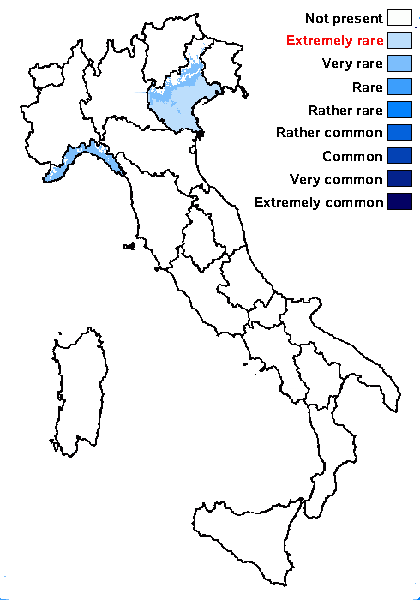Bacidina genuensis (B. de Lesd.) S. Ekman
Plant and Fungal Systematics, 68, 2: 280, 2023. Basionym: Bacidia genuensis B. de Lesd. - Bull. Soc. Bot. France, 84: 282, 1937.
Synonyms:
Distribution: N - Ven (Ekman 2023), Lig (Ekman 2023).
Description: Thallus crustose, episubstratic, continuous, yellowish grey in the herbarium (probably grey-green in a fresh state), of firmly fused, 30-85 μm wide granules forming irregular or shallowly incised, imbricate, minute squamules that sometimes bud tiny granules from the terminal segments (true soredia or blastidia absent); prothallus absent. Cortex of 1(-2) layers of thick-walled, ellipsoidal cells with 1.5-3 μm long lumina. Apothecia biatorine, 0.3-1 mm across, with an initially slightly concave, then convex, matt black (sometimes pale brownish yellow, blue-grey, or mottled) disc, and a concolorous to darker, sometimes faintly pruinose, finally excluded proper margin. Proper exciple 37-56 μm wide, often dark blue-green in uppermost part, sometimes pale orange-brown along edge, colourless within, sometimes with radiating clusters of minute crystals insoluble in K, the excipular hyphae indistinctly radiating, dichotomously branched and anastomosing, with cylindrical lumina, the terminal cells distinctly larger, up to 10 μm long. Epithecium blue-green; hymenium 61-73 μm high, making up 17-30% of the apothecium thickness, with blue-green vertical streaks reaching up to 2/3 of its thickness, without crystals; paraphyses 1.2-1.6 μm thick at mid-level, simple or sparingly branched in uppermost part, the apical cells subclavate 2.3-4.7 μm wide; hypothecium ± orange-brown (K+ intensifying) in upper part. Asci 8-spored, clavate the young spore mass with small and bluntly conical ocular chamber, the c-layer thick, non-amyloid, the d-layer thin, uniformly amyloid; axial body broadly dome-shaped, non-amyloid. Ascospores up to 7-septate, hyaline, acicular, straight or slightly curved, 23-43 x 1.2-2.3 μm, 13-28 times as long as wide. Pycnidia globose, immersed, unilocular, the wall blue-green around ostiole, otherwise unpigmented, with ampulliform conidiogenous cells. Conidia formed terminally, thread-like with blunt ends, curved, non-septate, 11-20 x c. 1 μm. Photobiont chlorococcoid. Spot tests: thallus K-, C-, KC-, P-. Chemistry: thallus without lichen substances; apothecia with the Bagliettoana-green pigment (proper exciple and hymenium, the pigment present also in the pycnidia) and the Rubella-orange pigment (hypothecium and sometimes proper exciple).Note: a long-forgotten and recently-resurrected species, known from the fortress of Peschiera del Garda in Veneto and from three different sites around Genova in Liguria. All specimens were collected on weathered mortar of masonry, probably in more or less shaded sites, often growing between small tufts of acrocarpous mosses (but only rarely overgrowing decaying moss tufts). For further details see Ekman (2023).
Growth form: Crustose
Substrata: rocks
Photobiont: green algae other than Trentepohlia
Reproductive strategy: mainly sexual
Commonnes-rarity: (info)
Alpine belt: absent
Subalpine belt: absent
Oromediterranean belt: absent
Montane belt: absent
Submediterranean belt: very rare
Padanian area: extremely rare
Humid submediterranean belt: very rare
Humid mediterranean belt: very rare
Dry mediterranean belt: absent

Predictive model

S. Ekman - Source: Ekman S. 2023. Bacidia genuensis B. de Lesd. resurrected. Plant and Fungal Systematics, 68, 2: 280-284. 2023. Bacidia genuensis B. de Lesd. resurrected. Plant and Fungal Systematics, 68, 2: 280-284.
A – thallus with apothecia. The straw color of the thallus is likely to be an herbarium artifact. Note the white pruina
on the margin of some apothecia. UPS L-947678;
Growth form: Crustose
Substrata: rocks
Photobiont: green algae other than Trentepohlia
Reproductive strategy: mainly sexual
Commonnes-rarity: (info)
Alpine belt: absent
Subalpine belt: absent
Oromediterranean belt: absent
Montane belt: absent
Submediterranean belt: very rare
Padanian area: extremely rare
Humid submediterranean belt: very rare
Humid mediterranean belt: very rare
Dry mediterranean belt: absent

Predictive model


